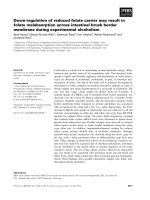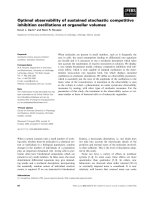Báo cáo khoa học: "A Combination of Atrioventricular Block and Sinoatrial Block in a Horse" ppt
Bạn đang xem bản rút gọn của tài liệu. Xem và tải ngay bản đầy đủ của tài liệu tại đây (955.66 KB, 3 trang )
Acta vet. scand. vol. 46 no. 3, 2005
In the process of carrying out a routine check
up examination on a group of horses of a riding
school in Shiraz, a horse demonstrated frequent
long pauses in heart rate of 33beats per minute
on auscultation. A base apex electrocardiogram
(ECG) was recorded to determine the type of
conduction disturbance. At the time of ECG
recording, the animal was normal with no ap-
parent sign of any body disorders and respira-
tory movement and temperature were within
normal range. CBC and serum biochemical
analysis carried out were within normal limits
of our school reference values. The horse was
given a light exercise and was examined imme-
diately after exercise and 15 minutes thereafter.
The heart rate immediately after the end of ex-
ercise was 65 bpm and slowed down to 35 bpm
15 minutes after exercise with no sign of heart
block.
ECG interpretation
The first two complexes of the ECG appeared to
be conducted normally through the heart fol-
lowing initiation of the sinoatrial node (Fig.1);
however, the P-R interval was variable and the
third P wave was blocked at the A-V node. The
mean P-P interval was about 1.80 second indi-
cating a sinus rate of 33 beats per minute. Fol-
lowing the first blocked P-wave, there was a
long pause, which was slightly more than twice
the previous P-P interval. There was no electri-
cal activity during this pause indicating a con-
comitant sinoatrial block (SAB). The underly-
ing rhythm was sinus arrhythmia as the P-P or
R-R intervals were variable. There was also a
single atrioventricular block (AVB) in the sec-
ond trace. No single SAB without accompany-
ing AVB was observed on the ECG.
Discussion
The prevalence of cardiac arrhythmias among
domestic animals is more common in the horse
(McGuirk & Muir 1985) than in other species
and the majority of these dysrhythmias are not
clinically significant. Sinus arrhythmia, sinoar-
trial block, wandering pacemaker, first and sec-
ond degree atrioventricular blocks are consid-
ered to be vagally mediated conduction distur-
bances and waxing and waning of the vagal
nerve is believed to be the cause of these car-
diac irregularities (Reef 1989). Of these cardiac
dysrhythmias, second degree AVB is more
common (Holmes 1990, Gabriel & Lekeux
1986). There are three types of AVB; that is,
first degree AVB in which all impulses origi-
nating from the SA node conduct to the ventri-
cle with longer than normal P-R interval (P-
R>0.50 sec.). Although this can be diagnosed
Acta vet. scand. 2005, 46, 173-175.
A Combination of Atrioventricular Block and
Sinoatrial Block in a Horse
By A. Rezakhani, M. Godarzi, I.Tabatabei Naeini
Department of Clinical Studies, School of Veterinary Medicine, Shiraz University, P.O. Box 1731, Shiraz 71345,
Iran.
Brief Communication
on auscultation, ECG is needed for confirma-
tion. In second degree AVB, some of the P
waves are not followed by the QRS complexes,
therefore, there are more P waves than QRS
complexes and during the missed beat the
fourth heart sound can be heard. There are two
types of second degree AVB. In type I, the P-R
interval lengthens gradually untill a P-wave is
blocked but in type II the P-R intervals remain
fixed. In third degree AVB, the electrical rela-
tionship of the atria and the ventricles are dis-
rupted.
The prevalence of second degree AVB is
around 15 to 40% in the equine population
(Reef 1989, Holmes 1990). It has been consid-
ered functional provided that it disappears after
light exercise (Holme 1990). It has been stated
that training has effect on the autonomic ner-
vous function (Ohmura et al. 2002) and vagally
mediated cardiac dysrythmias are more com-
mon in trained horses although AVB has also
been reported in a 2.5 months thoroughbred
foal (Matsui et al. 1988).There are also reports
that cardiac lesions can be associated with AVB
and SAB in the horse (Kiryu et al.1977, Kiryu
et al. 1985). The SAB occurs much less fre-
quent than AVB in horses (Smetzer 1967). Al-
though AVB and SAB may occur simultane-
ously on the ECG of a horse their association is
very rare. A review of literature showed that
only one case has been reported in a doctral the-
sis (Smetzer 1967) therefore, this can be ac-
cepted as the first published case of a concomi-
tant AVB and SAB in the horse. The horse was
clinically normal and used for jumping so this
type of conduction disturbance could be taken
as a functional block. However, periodic check-
ing of the cardiovascular system is recom-
mended.
174 A. Rezakhani et al.
Acta vet. scand. vol. 46 no. 3, 2005
Figure 1. Base -apex electrocardiogram recorded from a horse with concomitant second degree atrioventricu-
lar and sinoatrial block. The underlying rhythm is a slight sinus arrhythmia. The pause between the first blocked
P wave and the next P wave is slightly longer than 2 P-P intervals indicating SAB. Paper speed is 25mm per sec-
ond and calibration 10 mm equal to 1 mV.
References
Gabrie F, Lekeux P: Etude des arythmias cardiaques
chez 159 chevaux de selle Belges. Ann. Med.
Vet., 1986, 130, 205-214.
Holmes JR: Electrocardiography in the diagnosis of
common cardiac arrhythmias in the horse. Eq.
Vet. Edu., 1990, 2, 24-27.
Kiryu K, Kaneko K, Satoh H: Cardiopathological ob-
servations on histogensis of incomplete atrioven-
tricular block in horses. Jap. J. Vet. Sci., 1877, 39,
425-436.
Kiryu K, Kaneko M, Kanemura T, Yoshihara T,
Hasegawa M, Tomioka Y: Cardiopathology of
sinoatrial block in horses. Jap. J. Vet. Sci., 1985,
47, 45-54.
Matsui K, Amada A, Sawazaki H: Second -degree
atrioventricular block observed in a Thorough-
bred foal at 2.5 months of age. Jap. J . Vet. Sci.,
1988, 47, 175-178.
McGuirk SM, Muir WW: Diagnosis and treatment of
cardiac arrhythmias. Vet. Clin. N. Am., Eq. Pract.,
1985, 1, 353- 370
Ohmura H, Hiraga A, Aida H, Huwakara M, Tsubone
H: Effect of initial handling and training on auto-
nomic nervous function in young thoroughbreds.
Am. J. Vet. Res., 2002, 63, 1488-1491.
Reef VB: Frequency of cardiac arrhythmias and their
significance in normal horses. Proc. 7th., ACIVM
Forum, 1989, pp: 506-508.
Smetzer DL: Equine sinoatrial and second- degree
atrioventricular heart block. Ph.D. thesis, The
Ohio State University, U. S. A., 1967, p: 79.
Combined atrioventricular and sinoatrial block in a horse 175
Acta vet. scand. vol. 46 no. 3, 2005
(Received December 26, 2004; accepted April 25, 2005).
Reprints may be obtained from: Department of Clinical Studies, School of Veterinary Medicine, Shiraz Univer-
sity, P.O. Box 1731, Shiraz 71345, Iran. E-mail:









